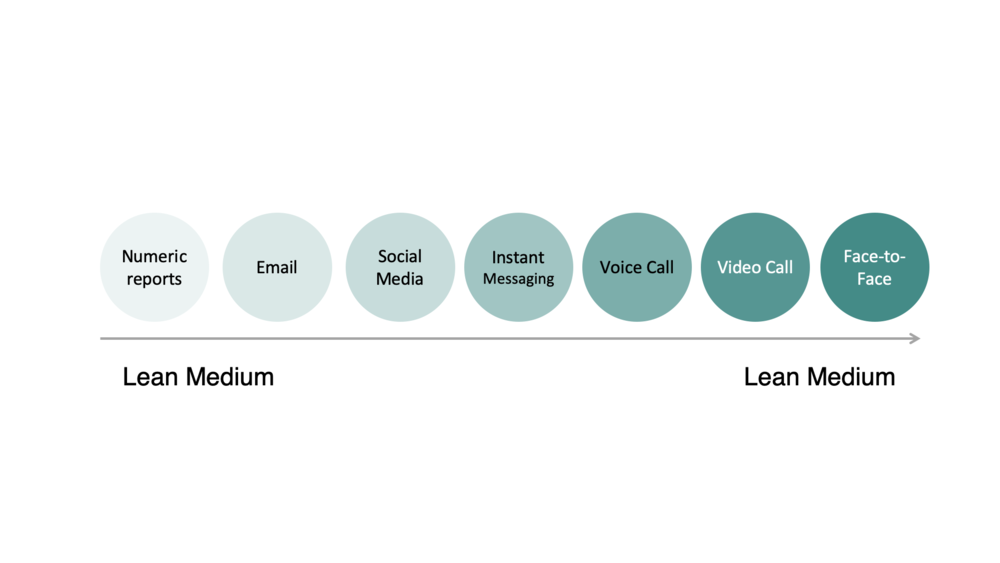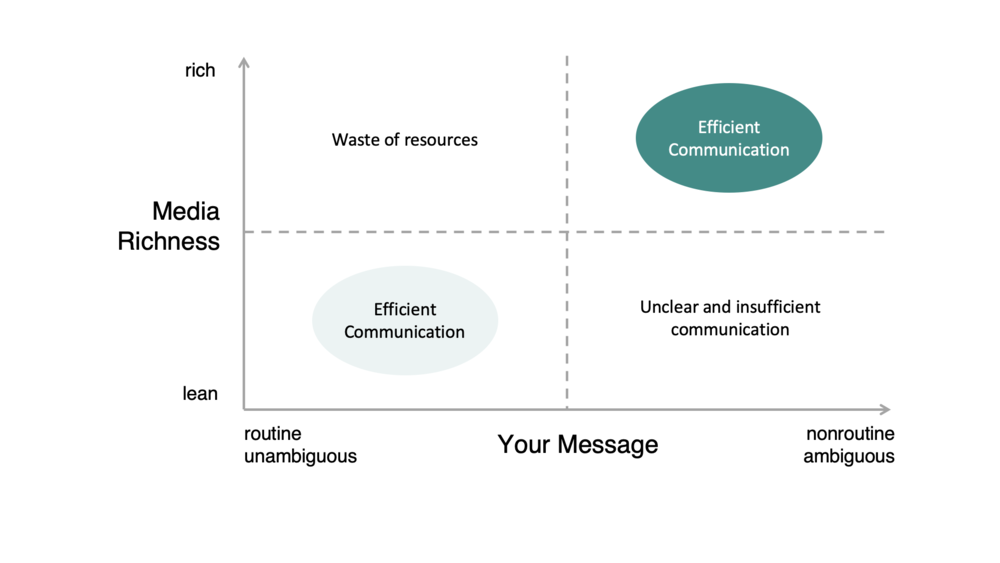Lean Media Vs Rich Media
Read in this blog post how to choose the right medium of communication with your team. We look at the concept of media richness and how it affects human communication. Learn when to use rich and when to use lean media.
Appropriate communication channels
I’ve done it. Sending out that critical message in an email that raises more questions than it answers. That is leaving your team unsure if they have done something wrong or uncertain of the future. Instead of sending that email, you should have just had a phone call or a conversation.
Especially with remote team members, the tendency to use asynchronous communication is high.
On the other hand, who hasn’t been to a meeting that should have been an email? Since they make coffee mugs with that saying (I own one), I figure it’s a common problem.
So what are we talking about here? The concept behind these things is media richness theory: the amount of data carried by a communication medium in terms of sheer data volume and — more importantly — in terms of data variety and the possibility for immediate feedback.

CHARACTERISTICS OF DIFFERENT TYPES OF COMMUNICATION MEDIUM
Face-to-face communication is by far the richest medium, as it carries a large variety of information (verbal and visual cues) and allows for immediate feedback that’s just as rich as the initial message. Think of how much your communication partner’s body language will tell you.
Video Calls are obviously less rich, but will still allow you to see gestures and other non-verbal communication.
Voice Calls, e.g. on you mobile phone, strip you of all non-verbal information and such are already far less rich. But still, they offer the opportunity for instant feedback.
The first asynchronous medium on the list is Instant Messaging, also SMS would be part of this group of communication channels. Not only can’t you hear the voice anymore, but also there’s no instant feedback anymore.
Social Media is usually even more asynchronous than instant messaging.
E-mail, being the most popular tool in business communication, is a rather lean medium and shouldn’t be used to communicate complex or ambiguous information.
On the end of the scale, a standardized report consisting mainly of numbers would be the leanest medium.
Choose the right medium
Lean media vs rich media: Effective communication will require you to choose the right communication channel for the topic at hand. To determine the right medium for communicating information, you should look at the nature of that information.
How familiar are your recipients with the content and context of your message? Is it routine? How clear is your information? Will it mean the same for everyone, or will its meaning change in different circumstances or contexts?
If your message is routine and unambiguous, you generally can rely on lean media formats like emails or reports. Or take press statements for example: Companies issue written statements for easy-to-understand, non-ambiguous and uncritical messages.
However, if your message is ambiguous and nonroutine, you should choose a richer medium, like a video call or a face-to-face conversation. To stay in the above example, for more complex or even critical information (such as in crises), companies will most likely use a press conferences over press statements, as they allow for rich communication and immediate feedback.
Just imagine how you managed through the first weeks of Covid-19. You most probably didn’t rely on email but used very instantaneous communication like calls or video calls to instantly capture feedback and be able to respond to questions.
Uhh yeah, I heard it through the grapevine (singing)
Generally speaking, when it comes to choosing the right medium for communicating with your team, your task as a CEO or entrepreneur is to balance two effects that your choice of communication medium will have on your business.
On the one hand, if you use an overly rich medium for a rather dull message, you are likely wasting time and resources — for example, if one of your team members calls a meeting (super-high media richness) to tell the team he will be off 30 minutes early to see the dentist (super unambiguous message).
That kind of waste is unnecessary and will fuddle with the medium’s long-term credibility. When you have to attend 10 meetings a week that “could have been an email,” your appreciation for that format will decrease.

On the other hand, using a lean medium for an ambiguous, nonroutine message will cause problems — for example, if you use e-mail to communicate a restructuring of your organization.
For you as a sender, this bears a high risk that your team will not decipher the full message because you can’t ensure they receive every part of it. There’s no immediate feedback.
Also, if an email doesn’t make sense, your team can’t easily obtain any missing information. What do you think happens when information is missing? Your team will find it somewhere else. Yup, the grapevine.
There’s nothing wrong with the grapevine itself; it is a vital nonformal communication instrument. But, if you want to get your message across as intended, you want to control it as much as possible — and you don’t want to leave it to the grapevine.
Your incomplete communication will cause decreased acceptance of your message, a delay in implementation or compliance, and so on.
It Depends.
Next to the basic rules, some contingencies exist regarding the right choice of media.
Social acceptance
Consider the social acceptance of a medium on a cultural, organizational, team, and individual level.
- Text messages are considered too impersonal for breaking up with your partner. How could email be sufficiently rich to tell someone that you’re letting them go?
- Things discussed in a meeting in one company or team will be sent around as a report in another company.
- One of your employees might like receiving new tasks by email, while another one appreciates a personal briefing.
On an individual level, your relationship to the receiver is important — you might use text messaging to scheduling a drink with your best friend, but you might tackle the same task in person with your new employee.
Social Presence Effect
You might deliberately choose not to communicate face-to-face in some situations: the presence of one communication partner might intimidate the other one.
To avoid this so-called Social Presence Effect, you can add a leaner medium to prepare a rich medium. For example, you could collect employee questions for the CEO before the town hall meeting instead of asking employees directly at the meeting — you might get an unfiltered set of questions without the CEO present.
Remote work
How does all of this apply to your team members who work remotely? By default, face-to-face communication is impossible for them.
My suggestion is trifold:
- For complex content, choose the richest mediums at your disposal, such as video conferencing.
- Echo the information that’s important to you. Echo the information that’s important to you.
- Ask your team members the questions that would inherently be answered in a richer medium: “Did this answer your question?,” “Do you understand my point?,” “Do you agree with my view on this?,” and so on. This might feel awkward, but it will improve your communications with remote team members.
What To Take Away
- For a critical message, any written format is likely not the best medium. Don’t use it.
- Use rich media like face-to-face or calls in times of high ambiguity, such as when implementing new processes. Once things become routine, switch to leaner communication (emails or reports).
- Question your communication habits: Can you increase the efficiency of routine tasks by switching to a leaner medium?
- Pay close attention to the individual communication styles of your team members and the organization. One size doesn’t fit all.
Actually pretty simple, right?
If the concept is so simple, why is it often ignored?
Guts and Patience.
You got to have the guts: Face any potential conflict. If you send an email to avoid an uncomfortable conversation, the conversation will almost certainly happen in an even more unpleasant way.
Be patient: Resist the temptation to just clean your desk by sending out written information. Schedule personal meetings instead if you have a nonroutine message to convey (stay tuned for a post on meetings!) or at least use the richest medium you can.
Be aware that your communication skills, and as part thereof the means of communication you choose, determine the communication culture that your company develops.
Let me know how you liked this post. Post your comments or questions in the comment section.
Best,
Benjamin